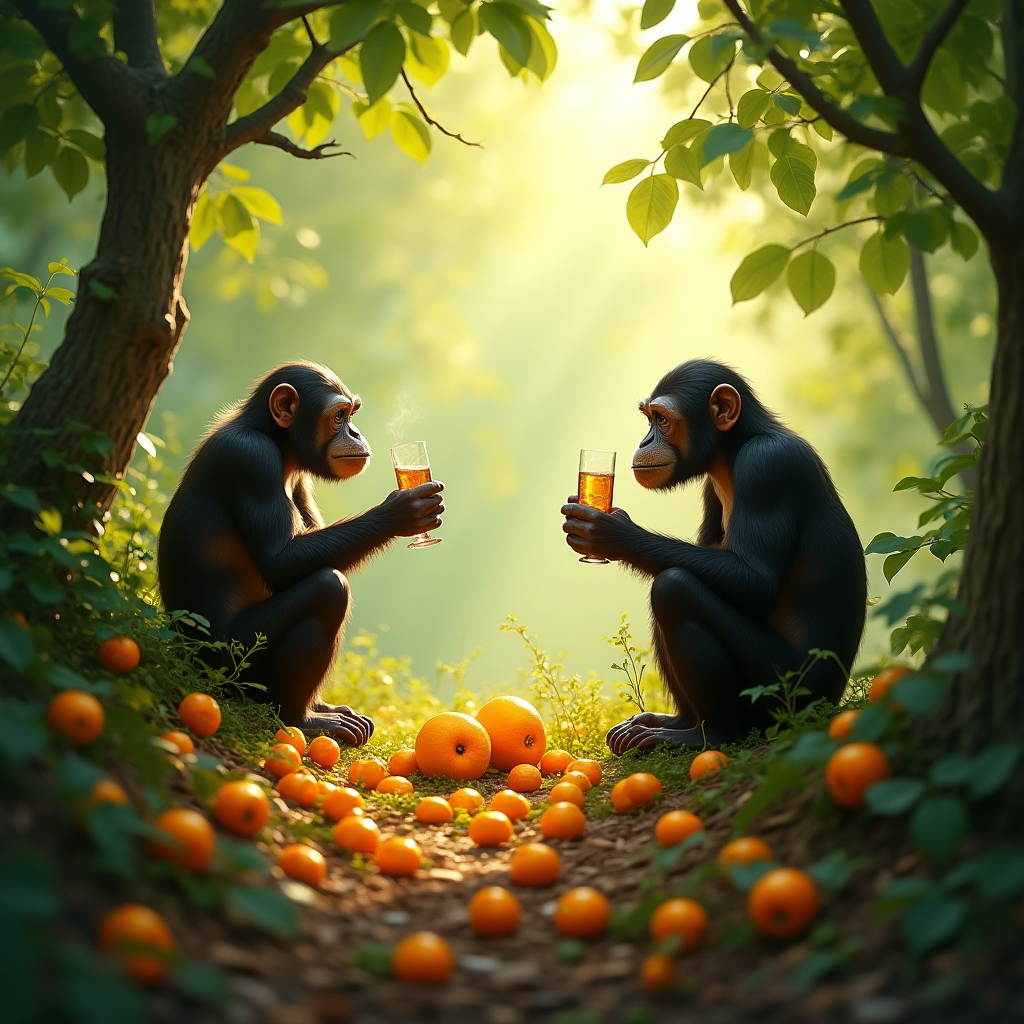African apes, cavorting through their lush forest habitats, have inadvertently provided scientists with a puzzle piece in the vast picture of human evolution. Their curious penchant for overripe, fermented fruits—now charmingly dubbed "scrumping"—might just explain why humans exhibit a remarkably high tolerance for alcohol.
iN SUMMARY
- 🍌 **Ape behavior** known as "scrumping" involves consuming fermented fruit, hinting at alcohol tolerance evolution.
- 🔍 Studies suggest ancestral behavior might have led to key **evolutionary adaptations** in humans.
- 🍇 Humans' ability to digest alcohol may be linked to **social and survival behaviors** shared with our ancestors.
- 🌍 Understanding these behaviors can shed light on modern-day **social drinking practices**.
The Origins of Scrumping: A Peek into Ape Social Life
Deep within the rich ecosystems of Africa, apes gather in communities, indulging in a practice that has kept scientists intrigued. They feast on fruits fallen ripe and heavy with fermentation—essentially nature’s own cocktail. This activity, coined as "scrumping," might resemble a joyous gathering rather than a calculated dietary habit.
According to researchers, these apes’ dietary choices might not be mere happenstance. The consumption of naturally occurring ethanol in such fruits is believed to have instigated an essential adaptation process in our shared ancestors. This behavior, reflective of an innate inquisitiveness and adaptability, may have led to enhanced alcohol metabolism (ScienceDaily, https://www.sciencedaily.com/releases/2025/08/250801020109.htm).
Evolution and Ethanol Metabolism: Nature’s Experiment?
Think of it this way: imagine a group of early primates, reliant on forest fruits for sustenance, encountering a selection of fermented offerings. Those that could metabolize alcohol with ease might have enjoyed a slight edge—an added caloric intake without the adverse effects usually tied to inebriation. Over time, this prehistoric tolerance for alcohol might have paved the way for social interactions similar to our modern-day gatherings, most notably those in bustling urban centers like Calgary or perhaps the corners of Auckland.
The Science of Scrumping: A Chemical Affair
What precisely happens during this consumption? When an ape chomps down on fermented fruit, their systems begin the remarkable task of ethanol metabolization. Our scent trails back to these ancestors align with the scientific theory that explains our contemporary liver efficiency in alcohol breakdown (Nature, https://www.nature.com).
This potentially adaptive response unfolds much like an intricate dance, enabling both apes and humans to derive energy from these finds without succumbing to over-intoxication. This aligns seamlessly with the methodologies of Victoria, where social rituals often celebrate with shared toasts.
From Forest Floors to Festive Gatherings: The Societal Reflection
Today, remnants of this evolutionary quirk allow communities globally to partake in sociable wine-tasting, beer crafting, and festive rejoicing. This concept might resonate during a bustling evening in cities such as New York or Chicago, where the fruits of ethanol digestion are celebrated and well-received.
This societal mirroring suggests that our tolerance to alcohol isn’t merely a personal trait but a complex legacy embedded deep within our social constructs. Whether we realize it or not, this ancient dietary choice continues to influence modern human society.
Practical Tips and Further Exploration
For those intrigued by our primate cousins’ intriguing habits, consider these options for further engagement:
- 📚 Delve deeper into the historical aspects and explore books detailing primate behavior. Use an Amazon Canada">Amazon product link for a comprehensive guide.
- 🎥 Documentary lovers can learn about primate life through acclaimed visual storytelling platforms.
- 🐒 Support conservation efforts aimed at protecting these intelligent creatures and their diverse habitats.
Conclusion: A Toast to Evolution’s Wonders
Our journey across millennia from the forest floor to the festive table remains a tribute to nature's ingenuity. It’s astonishing to realize how ancient feeding habits have influenced modern social constructs.
Next time you enjoy a convivial drink with friends in places like London or even sunny Sydney, remember: you are partaking in a legacy passed down through generations, crafted lovingly in the cradle of evolution.
What would you do if you discovered more evolutionary surprises embedded in our everyday habits? Share your thoughts in the comments, and join the iNthacity community to explore the interconnected tapestry of life. Consider applying to become permanent residents, then citizens of the "Shining City on the Web".
Here’s to embracing the unpredictable yet thrilling reality that is life, much like our ancestors did, with curiosity and a hearty spirit!
Disclaimer: This article may contain affiliate links. If you click on these links and make a purchase, we may receive a commission at no additional cost to you. Our recommendations and reviews are always independent and objective, aiming to provide you with the best information and resources.
Get Exclusive Stories, Photos, Art & Offers - Subscribe Today!
























Post Comment
You must be logged in to post a comment.